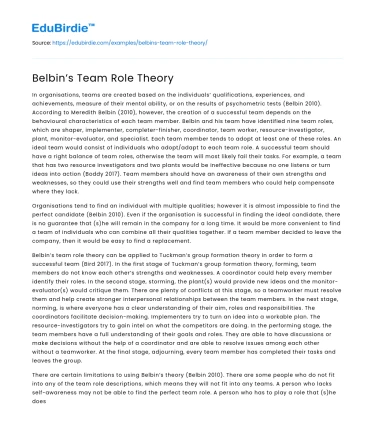In organisations, teams are created based on the individuals’ qualifications, experiences, and achievements, measure of their mental ability, or on the results of psychometric tests (Belbin 2010). According to Meredith Belbin (2010), however, the creation of a successful team depends on the behavioural characteristics of each team member. Belbin and his team have identified nine team roles, which are shaper, implementer, completer-finisher, coordinator, team worker, resource-investigator, plant, monitor-evaluator, and specialist. Each team member tends to adopt at least one of these roles. An ideal team would consist of individuals who adopt/adapt to each team role. A successful team should have a right balance of team roles, otherwise the team will most likely fail their tasks. For example, a team that has two resource investigators and two plants would be ineffective because no one listens or turn ideas into action (Boddy 2017). Team members should have an awareness of their own strengths and weaknesses, so they could use their strengths well and find team members who could help compensate where they lack.
Organisations tend to find an individual with multiple qualities; however it is almost impossible to find the perfect candidate (Belbin 2010). Even if the organisation is successful in finding the ideal candidate, there is no guarantee that (s)he will remain in the company for a long time. It would be more convenient to find a team of individuals who can combine all their qualities together. If a team member decided to leave the company, then it would be easy to find a replacement.
Save your time!
We can take care of your essay
- Proper editing and formatting
- Free revision, title page, and bibliography
- Flexible prices and money-back guarantee
Belbin’s team role theory can be applied to Tuckman’s group formation theory in order to form a successful team (Bird 2017). In the first stage of Tuckman’s group formation theory, forming, team members do not know each other’s strengths and weaknesses. A coordinator could help every member identify their roles. In the second stage, storming, the plant(s) would provide new ideas and the monitor-evaluator(s) would critique them. There are plenty of conflicts at this stage, so a teamworker must resolve them and help create stronger interpersonal relationships between the team members. In the next stage, norming, is where everyone has a clear understanding of their aim, roles and responsibilities. The coordinators facilitate decision-making. Implementers try to turn an idea into a workable plan. The resource-investigators try to gain intel on what the competitors are doing. In the performing stage, the team members have a full understanding of their goals and roles. They are able to have discussions or make decisions without the help of a coordinator and are able to resolve issues among each other without a teamworker. At the final stage, adjourning, every team member has completed their tasks and leaves the group.
There are certain limitations to using Belbin’s theory (Belbin 2010). There are some people who do not fit into any of the team role descriptions, which means they will not fit into any teams. A person who lacks self-awareness may not be able to find the perfect team role. A person who has to play a role that (s)he does not want to would cause conflict between his/herself and other teammates.
References
- Belbin, R. M. (2010) Management Teams: Why They Succeed or Fail. 3rd edition. Oxford: Butterworth Heinemann.
- Bird, V. (2017) Belbin and Tuckman: Supporting Your Team at Every Stage. The Belbin Team. https://www.belbin.com/resources/blogs/belbin-and-tuckman/ Accessed November 27 2019.






 Stuck on your essay?
Stuck on your essay?

